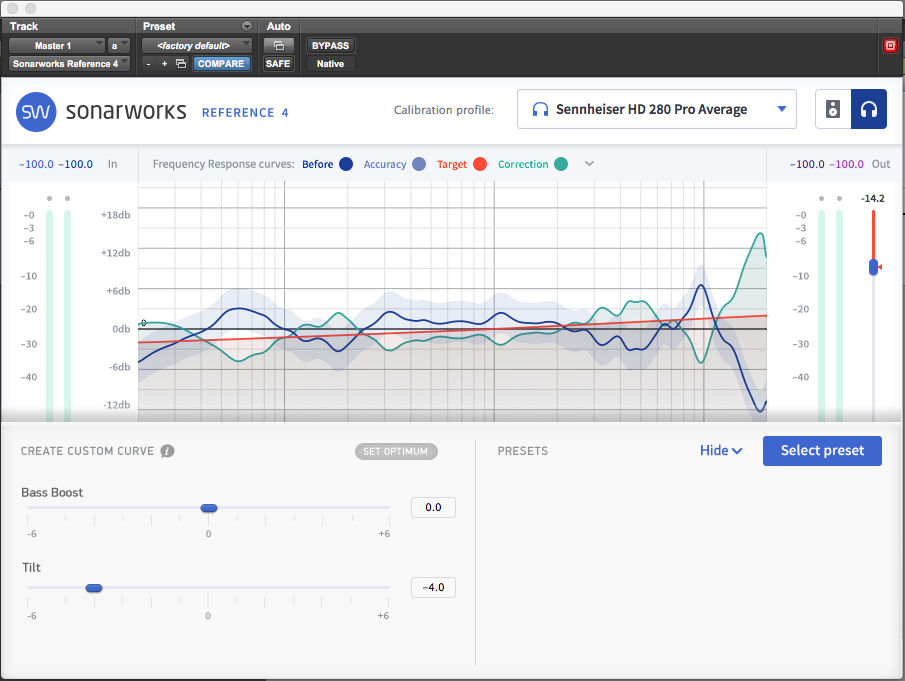

- SONARWORKS REFERENCE 4 GEARSLUTZ FULL
- SONARWORKS REFERENCE 4 GEARSLUTZ PRO
- SONARWORKS REFERENCE 4 GEARSLUTZ SOFTWARE
On top of the new headphone models and in-room calibration, Reference 4 has included what I feel is the missing link between technical and practical everyday use. The result is a more balanced response around the listening area. A measurement is taken at each location around the sweet spot and the EQ curve is smoothed to account for random peaks or notches.
SONARWORKS REFERENCE 4 GEARSLUTZ SOFTWARE
To simplify matters, the software uses sound and time-based calculations to know where you are in the room and guide the mic through 37 positions around the listening position. This is accomplished with an individually calibrated mic, their Reference 4 Measure software, and quite a bit of moving around the room holding the mic. What Reference 4 Studio adds is the option to analyze your specific mixing environment. With this even response across all frequencies, better choices can be made during mixing. Once the response is mapped, the overall average curve can be corrected to “flatten” the headphone’s response. To combat this, Sonarworks has gone to great lengths to map the individual average frequency response of over 200 different headphone models. While it may be fun to listen to for leisure, this can really cloud the decision-making process during mixing. In most cases, the mids are scooped, the highs boosted, and the lows hyped. While each headphone manufacturer throws “special sauce” into their designs, coloration ensues. So, what do we actually have here? For those who are new to the concept, Reference 4 levels the playing field between different listening devices. This review will have a companion review of the software once the room is complete, along with a very exciting project in the works. And yes, I know I’m using the software in an extreme case to see just how far the software can assist, but this is not a recommendation for everyday use. Think of Sonarworks as a companion to an already good foundation. Phase issues along with standing waves are still a big factor in a balanced room and need physical intervention. Yes, Sonarworks helps mixes translate better in regard to both the room and the speakers, but this is no replacement for sound treatment in a room. It has to be stated that Sonarworks is not a cure-all tool. Both versions include over 200 headphone profiles as well, expanding vastly from Reference 3. Studio Edition also comes with the Speaker Measurement software. Both versions come with the DAW plugin, reference sound combined with zero latency for any musical endeavor, and even the new Systemwide software, which applies the calibration to all outgoing audio.

Studio Edition handles both headphones and speakers. Headphone Edition handles the mixing with headphones only. The software has expanded to two different versions. While Reference 3 only dealt with headphones, Reference 4 comes out swinging with more options.
SONARWORKS REFERENCE 4 GEARSLUTZ PRO
I am going to try to mix in a completely untreated room JUST using Sonarworks Reference 4 both on my Beyerdynamic DT770 Pro headphones and on my Focal Solo 6 monitors. Equipped with Sonarworks’ option to measure the frequency response in a room and apply it to my speakers, I have the perfect opportunity to see juuuust how far this software can go. Now, I find myself with a newly built mixing room that has not yet been treated and was reminded about this software.
SONARWORKS REFERENCE 4 GEARSLUTZ FULL
I was intrigued, but unfortunately, the cares of life and an inbox full of press releases distracted me. Several years ago, I started seeing the appearance of Sonarworks, a company offering the ability to mix with certain sets of headphones by flattening the frequency response. I honestly almost quit mixing altogether. This drove me to buy several sets of headphones that promised a “flatter response” but the resulting mix didn’t translate either. I spent thousands of dollars in treatment, mixes would sound awesome in the room, but bad everywhere else. This was a recurring issue for me personally in my last room. Whether it be poorly treated rooms or headphones, these scenarios pose their own set of risks and leave the mix engineer frustrated that the mix didn’t translate to any other set of speakers. Some engineers even give up on trying to mix in their rooms and break the “cardinal sin of mixing” – using headphones.

While I’m a bit more fortunate to have an understanding wife who had a room built for me, even the limitations of home renovation pose an array of constraints. Usually we’re given the scraps of a small bedroom by our significant other and are forced to make the best of it. Most of us mere mortals do not have the most ideal mixing environment.


 0 kommentar(er)
0 kommentar(er)
